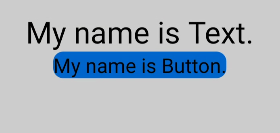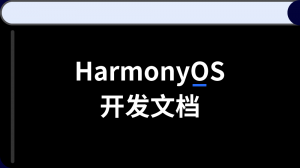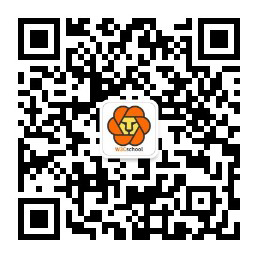鸿蒙OS 组件与布局代码创建布局
2020-09-18 11:51 更新
开发如下图所示界面,需要添加一个 Text 组件和 Button 组件。由于两个组件从上到下依次居中排列,可以选择使用竖向的 DirectionalLayout 布局来放置组件。
图1 开发样例图

代码创建布局需要分别创建组件和布局,并将它们进行组织关联。
创建组件
- 声明组件
Button button = new Button(context); // 参数context表示AbilitySlice的Context对象
- 设置组件大小
button.setWidth(ComponentContainer.LayoutConfig.MATCH_CONTENT); button.setHeight(ComponentContainer.LayoutConfig.MATCH_CONTENT);
- 设置组件属性及ID
button.setText("My name is Button."); button.setTextSize(25); button.setId(ID_BUTTON);
创建布局并使用
- 声明布局
DirectionalLayout directionalLayout = new DirectionalLayout(context);
- 设置布局大小
directionalLayout.setWidth(ComponentContainer.LayoutConfig.MATCH_PARENT); directionalLayout.setHeight(ComponentContainer.LayoutConfig.MATCH_PARENT);
- 设置布局属性及 ID
directionalLayout.setOrientation(Component.VERTICAL);
- 将组件添加到布局中(视布局需要对组件设置布局属性进行约束)
directionalLayout.addComponent(button);
- 将布局添加到组件树中
setUIContent(directionalLayout);
完整代码示例:
@Overridepublic void onStart(Intent intent) { super.onStart(intent); // 步骤1 声明布局 DirectionalLayout directionalLayout = new DirectionalLayout(context); // 步骤2 设置布局大小 directionalLayout.setWidth(ComponentContainer.LayoutConfig.MATCH_PARENT); directionalLayout.setHeight(ComponentContainer.LayoutConfig.MATCH_PARENT); // 步骤3 设置布局属性及ID(ID视需要设置即可) directionalLayout.setOrientation(Component.VERTICAL); directionalLayout.setPadding(32, 32, 32, 32); Text text = new Text(context); text.setText("My name is Text."); text.setTextSize(50); text.setId(100); // 步骤4.1 为组件添加对应布局的布局属性 DirectionalLayout.LayoutConfig layoutConfig = new DirectionalLayout.LayoutConfig(LayoutConfig.MATCH_CONTENT, LayoutConfig.MATCH_CONTENT); layoutConfig.alignment = LayoutAlignment.HORIZONTAL_CENTER; text.setLayoutConfig(layoutConfig); // 步骤4.2 将Text添加到布局中 directionalLayout.addComponent(text); // 类似的添加一个Button Button button = new Button(context); layoutConfig.setMargins(0, 50, 0, 0); button.setLayoutConfig(layoutConfig); button.setText("My name is Button."); button.setTextSize(50); button.setId(100); ShapeElement background = new ShapeElement(); background.setRgbColor(new RgbColor(0, 125, 255)); background.setCornerRadius(25); button.setBackground(background); button.setPadding(10, 10, 10, 10); button.setClickedListener(new Component.ClickedListener() { @Override // 在组件中增加对点击事件的检测 public void onClick(Component Component) { // 此处添加按钮被点击需要执行的操作 } }); directionalLayout.addComponent(button); // 步骤5 将布局作为根布局添加到视图树中 super.setUIContent(directionalLayout);}
根据以上步骤创建组件和布局后的界面显示效果如[图1]所示。其中,代码示例中为组件设置了一个按键回调,在按键被按下后,应用会执行自定义的操作。
在代码示例中,可以看到设置组件大小的方法有两种:
- 通过 setWidth/setHeight 直接设置宽高。
- 通过 setLayoutConfig 方法设置布局属性来设定宽高。
这两种方法的区别是后者还可以增加更多的布局属性设置,例如:使用“alignment”设置水平居中的约束。另外,这两种方法设置的宽高以最后设置的作为最终结果。它们的取值一致,可以是以下取值:
- 具体以像素为单位的数值。
- MATCH_PARENT:表示组件大小将扩展为父组件允许的最大值,它将占据父组件方向上的剩余大小。
- MATCH_CONTENT:表示组件大小与它内容占据的大小范围相适应。
以上内容是否对您有帮助:

 免费AI编程助手
免费AI编程助手



更多建议: